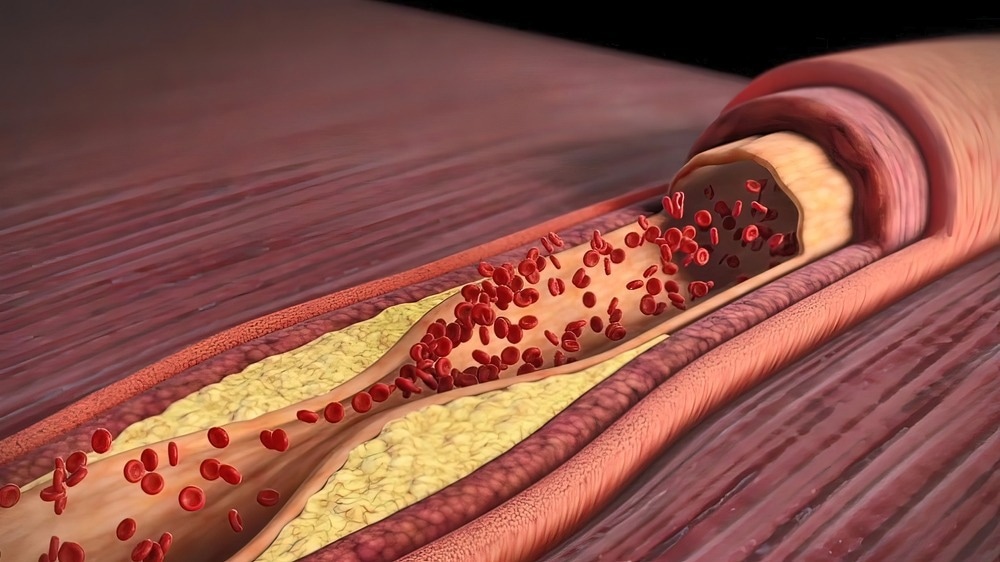Atherosclerosis is the accumulation of cholesterol, fats, and other substances in and on the artery walls. These accumulations are referred to as plaque, which causes narrowing of the arteries that can ultimately reduce blood flow.
Analysis of coronary artery calcium (CAC) helps determine the coronary atherosclerotic plaque, which is a strong indicator of an individual’s risk of coronary heart disease (CHD) and cardiovascular disease (CVD).

Study: Coronary Artery Calcium Dispersion and CauseSpecific Mortality. Image Credit: picmedical / Shutterstock.com
Background
CAC scoring and risk prediction models are incorporated into clinical practice guidelines to better understand the possible incidence of a particular disease.
CAC density has been found to be inversely associated with CHD and CVD events. Several therapies have been designed to minimize these events. For example, statin therapy increases CAC by creating more dense plaque, which indicates stabilization.
Similar to CAC scoring, Agatston scoring is commonly used to predict CVD events. Agatston score predictability could be improved by quantifying and identifying the number of vessels affected by atherosclerosis. Thus, the overall assessment of CAC distribution and amount of calcified plaque improves Agatston score predictability.
In a recent American Journal of Cardiology study, scientists determine whether the estimation of CAC dispersion, based on the number of calcified vessels or CAC phenotype, could determine all-cause and causes of specific mortality.
About the study
The current study used the CAC Consortium, which is a retrospective cohort study consisting of 66,636 participants from institutions located in Ohio, Minnesota, and California.
All study participants were adults and presented with asymptomatic CHD. Importantly, participants whose CAC scores were above zero were included in this study.
Furthermore, study participants with a CAC score greater than two were included for an index of diffusion (ID) analysis. This analysis accounts for how much each vessel contributes to the total Agatston score, which has been associated with all-cause and cause-specific mortality.
From the CAC Consortium, a total of 28,147 participants, 25% female and 75% male, whose mean age was 58 years, fulfilled the eligibility criteria. The participants’ CAC scans were obtained through multidetector computed tomography (CT) or electron beam tomography. The calcium score was quantified using the Agatston method.
Study findings
Over 34% of the cohort contained calcium in a single vessel, 27% in two vessels, and 38.7% in three or four vessels. Typically, older, male, and non-White individuals showed calcium in multiple vessels.
CAC dispersion, which was defined by vessel number or ID phenotypes in relation to cause-specific mortality, was analyzed using the retrospective cohort. The ratio of participants with three or four vessel involvement rose with an increase in the CAC strata. A diffused phenotype was strongly linked with an increased risk of CVD-specific mortality as compared to a concentrated phenotype.
Previous studies on coronary CT angiography demonstrated the importance of this non-invasive technique for the detection of multivessel disease among patients with diabetes and hypertension. Interestingly, the present study observed that individuals with diabetes, hypertension, hyperlipidemia, or current smokers have an increased number of vessels with calcium. This finding was also validated in autopsy data, which revealed a high-grade multivessel atherosclerotic disease in 58% of patients with diabetes.
Consistent with previous reports, the present study revealed increased vessel involvement to be a poor prognostic marker among those with calcified coronary vessels.
Recently, the Society of Cardiovascular Computed Tomography has developed a method to incorporate vessel numbers into CAC reports, which is known as the CAC-Data Reporting System (CAC DRS). This system offers a standardized approach to reporting the Agatston score or visual assessment with the vessel number.
The main importance of this initiative is the accurate prediction and diagnosis of CVD events and CHD. For example, increased CAC DRS scores would indicate the need for immediate risk factor modification and the introduction of more intensive therapies.
The authors recommend the additional incorporation of CAC dispersion and total CAC scores into reports, which would suggest the approximate total plaque burden.
Ultimately, knowledge about the total plaque burden in blood vessels would help clinicians make an appropriate diagnosis and design proper treatment for the patient. Previous studies have revealed that total plaque burden is a prominent predictor of subsequent cardiovascular death.
Conclusions
A strong association was observed between traditional diseases such as diabetes and hypertension and diffused CAC distribution based on race and gender. The vessel number was also linked with enhanced mortality from CHD, CVD, or any cause.
In this study, the authors recommend the incorporation of CAC distribution details in future CAC score algorithms to improve the clinical management of CVD events.
Journal reference:
- Dudum, R., Dardari, Z., Feldman, D., et al. (2023) Coronary Artery Calcium Dispersion and CauseSpecific Mortality. The American Journal of Cardiology 191; 76-83. doi:10.1016/j.amjcard.2022.12.014